Last Updated on 19/11/2023
Rothenburg ob der Tauber is a city with a medieval look, which is located on several tourist routes at once: Romantic Road, Castle Road and Favorite Valley of the Tauber River.
Old streets that seem to have survived from ancient times, half-timbered houses, fortress walls, the picturesque nature of the Tauber River valley (although the river is too loud a word for this stream) … A significant part of this medieval appearance has been restored from ruins after the bombing, according to old drawings and photographs. But walking here, you completely forget about it.
Romantic Franconia map of attractions
From Ulm to Ellwangen. Albtrauf and Bavarian Swabia
Nuremberg What to see
Autumn in Swabian “Tuscany”
Castle Road. 3. From Sinsheim to Rothenburg ob der Tauber
Castle Road. 2. From Zwingenberg to Bad Wimpfen
Dennenlohe. Rhododendron Garden
Schwäbisch Hall. 1. What to see in old town
It is worth visiting Rothenburg during the holidays, especially on Easter and Trinity, when locals, dressed in costumes, try to recreate the life of the city in the Middle Ages and important historical events for the city.
A little history
The first small castle over Tauber was built by the Counts of Comburg-Rothenburg. The first mention of them appears in the 11th century. Count Henrich von Rothenburg, the last of the family, handed the castle over to the Comburg monastery, which was founded by his family.
In the 12th century, the site was acquired by King Konrad and began to build a castle Rothenburg.
Read more about Comburg.
Konrad’s son Frederick the Handsome was too young to become emperor. Therefore, Frederick 1 Barbarossa becomes emperor, and Frederick the Handsome receives the title of Duke of Rothenburg. After the death of Frederick the Handsome in 1167, Rothenburg passed to Frederick Barbarossa. In 1172 the settlement was given the status of a city, the first fortress walls were built (the White Tower, St. Mark’s Tower, Röder Arch were preserved).
Since 1204, new fortifications have been built to cover the expanded city. In 1274 Rothenburg became a free imperial city, and in 1352 achieved independence from the empire. In 1356 an earthquake destroyed the city fortifications. A two-tiered bridge was built over the Tauber.
At the beginning of the 15th century under the burgomaster Toppler, the city is experiencing a new heyday. In 1520 the Jewish population was expelled from the city.
Rothenburg was forced to take part in a peasant uprising in the 15th and 16th centuries, the wars of the margraves and the Thirty Years’ War. In 1650, the wars ended, but the city became impoverished and lost its significance, the population was reduced by half.
Rothenburg became subordinate to Bavaria In 1802. In 1945, the city was destroyed during the bombing.
Rothenburg map
Rothenburg is a great choice for a day trip or a stopover along the way.
The map shows the recommended route. And it is worth using it to go through the most interesting places, especially if you come for one day, since the city cannot be called very small.
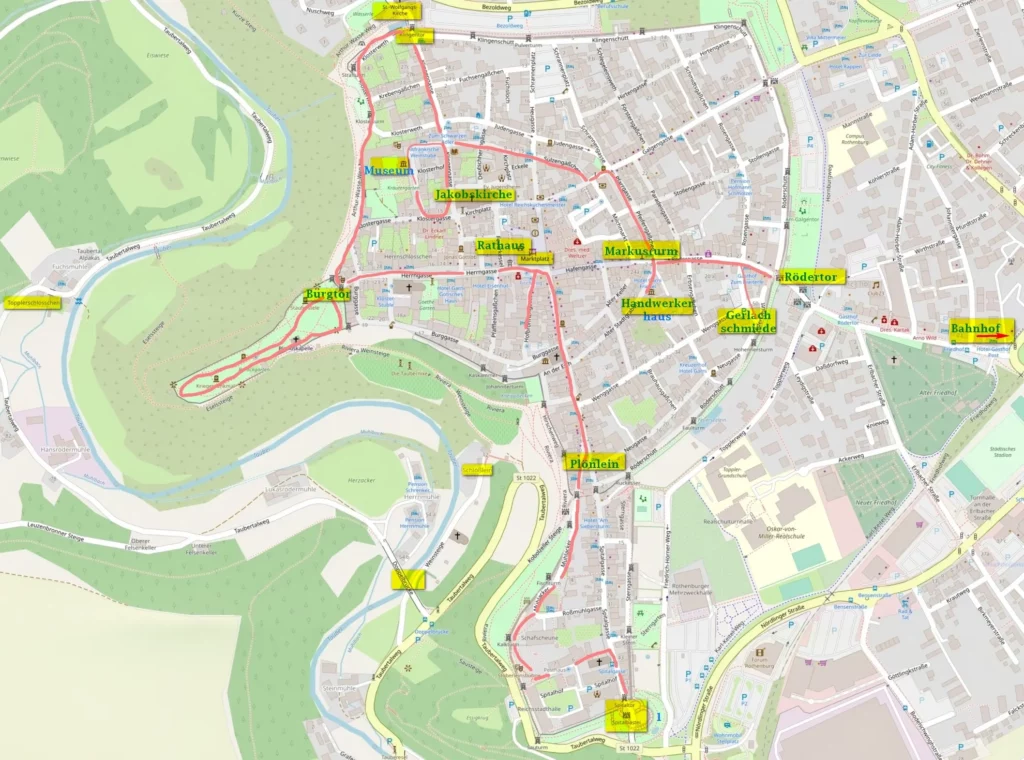
Rothenburg what to see
From the station we go along Ansbacherstrasse and very quickly get to the fortress walls. Parking lots are around the old town.
We start with the hospital bastion (Spitalbastei), the newest part of the city’s fortifications.
On the route, we turn left and go through the city walls. They offer a wonderful view of the Tauber Valley and the city itself.

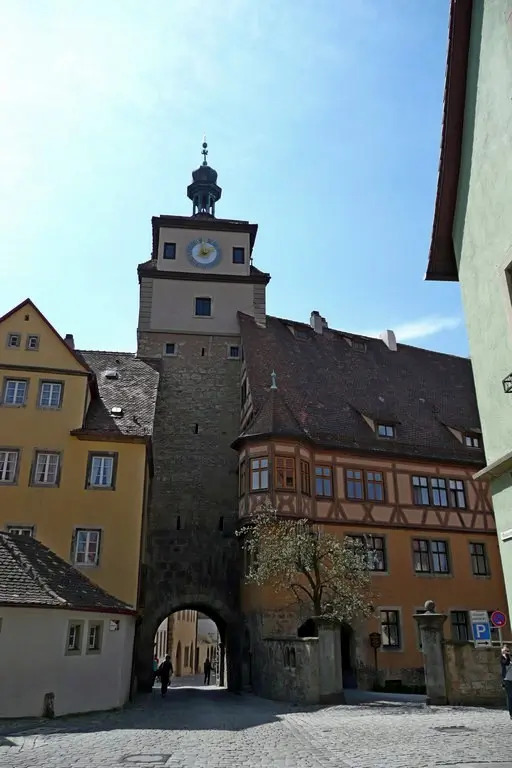


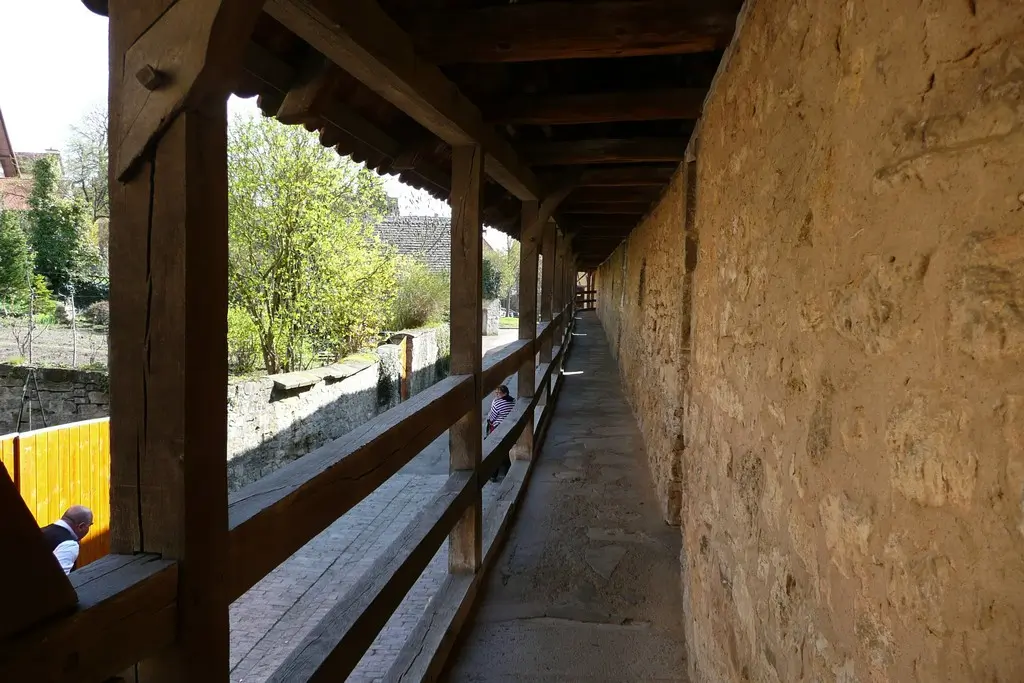
The walls lead to Schmiedgasse, along it we go straight to the very center of the city – the Market Square (Marktplatz) and the Town Hall.
On the route Plönlein – the most photographed place in Rothenburg and the most recognizable.



Marktplatz
The Marktplatz is a sign of towns central point for the traveler in Germany, just like High Street is a such sign in England. In old cities, this is in most cases the very center of the city. Here both before and now (usually once or twice a week) the market opens.

The town hall (Rathaus) building dominates the square. From the 13th century there was a Gothic town hall of two adjacent buildings. One half (with a white tower) has survived to this day. The second was rebuilt in the Renaissance style in the second half of the 16th century. In the 17th century a baroque gallery with arches was added.
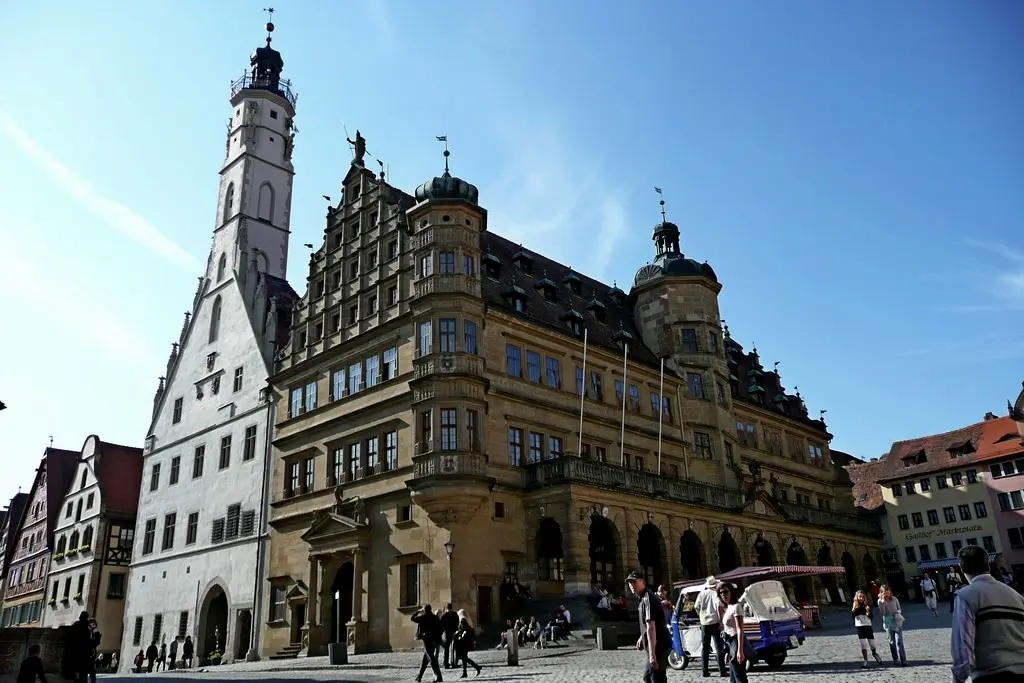
Follow me
You can visit the town hall and see the large Gothic Imperial Hall, a panel from the 16th century with the image of the Last Judgment. You can also go up to the observation deck of the tower, see an exposition showing scenes from the Thirty Years War and household items.
On the market square every hour from 11 to 15 and at 21, 22 o’clock the city clock shows a performance. The figures appear in the side windows and tell how the burgomaster of the city drank a huge mug of local wine (3 liters and a quarter). For this, the admiring imperial warlord Tilly decided not to ravage the city during the Thirty Years War.


Opposite the town hall is one of the fountains in the city (1608), decorated with a statue of St. George. Behind the fountain there are two old half-timbered houses. This is the house of the burgomaster Jagstheimer, where the emperor Maximilian 1 stayed. And the house of the butcher’s shop, where meat was sold and dances were held on holidays.


Along the street Herrngasse, past the aristocratic mansions and the Franciscan church, we go to the city gate (Burgtor).
The long rocky spur above Tauber was once the castle that defended the city. In 1356 an earthquake destroyed the castle. Later, for protection, the city gate with a tower was built, which has survived to this day.
There is another wonderful view of the river gorge from the park.
Below are several old city mills, a two-tiered bridge (14th century), a small Toppler palace. Toppler is one of the most famous and wealthy burgomasters. He ended up in prison for supporting the wrong king.








From here we go to the Klingentor gate and the church of St. Wolfgang, interesting in that it was part of the city fortifications and was adapted for defense.




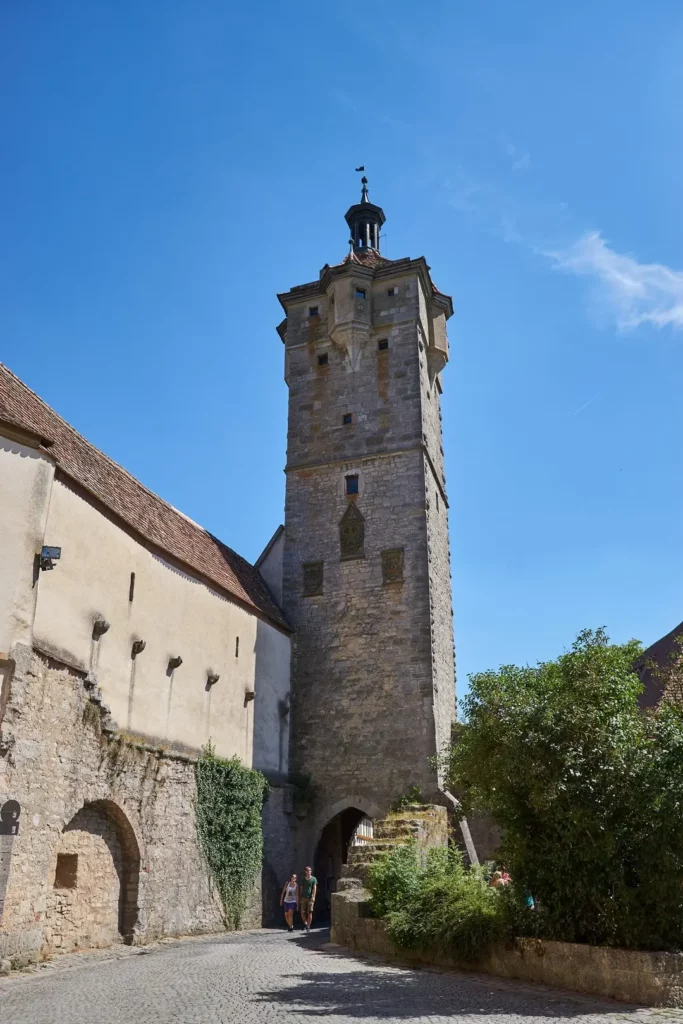

Jakobskirche
However, the main church of the city is the church of St. Jacob (Jakobskirche). This late Gothic church, which dominates the city, was commissioned by the German Order. Its headquarters were located further along the Tauber Valley, in Bad Mergentheim, in the 14th and 15th centuries.
Now it contains works of religious art dating back to the 13th century. The most significant is the Altar of Holy Blood with a scene of the Last Supper, made at the beginning of the 16th century by the famous German Renaissance sculptor Tillmann Riemenschneider.


Opposite the church is the Rothenburg Museum. It is located in the building of the Dominican convent, founded in 1258.
The museum reproduces a medieval monastery, exhibits items related to the history of the city, including the famous mug with a capacity of 3 liters and a quarter, furniture, household utensils, craft tools, medieval icons and paintings depicting views of the city.
From here you can walk along any of the old streets so that later you can go to the tower of St. Mark (Markusturm, built in the 12th century), the handicraft house (Handwerkerhaus), and then to the Rödertor Gate (13th century) and a pretty old house – Gerlach’s forge (Gerlach Schmiede).
Markusturm

House of Crafts – an old house of the 13th century, preserved in an almost unchanged form, show the interiors of craftsmen’s houses.
At this point, the sightseeing tour can be considered finished. You can again climb the walls and go back to the Hospital Bastion, or go for a walk around the city. At least 3 hours should be allocated for a leisurely tour of the city with climbing the walls, plus time for visiting museums if desired.
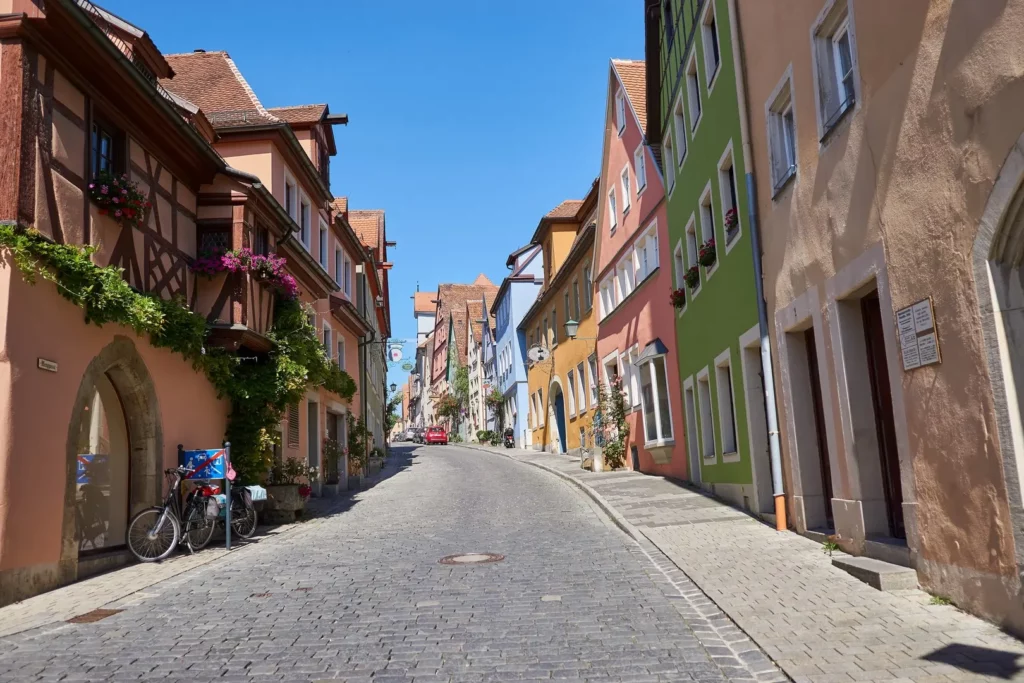
Museums
In addition to the already mentioned
- museum in the town hall,
- the museum of the imperial city,
- the house of crafts
- and the church of St. Jacob,
the city has
- a German Christmas Museum-Shop (Weihnachtsdorf),
- a museum of medieval criminal history with instruments of torture, shameful masks and similar other items.
Other topics by region – #Castle road
Romantic Franconia map of attractions
From Ulm to Ellwangen. Albtrauf and Bavarian Swabia
Nuremberg What to see
Autumn in Swabian “Tuscany”
Castle Road. 3. From Sinsheim to Rothenburg ob der Tauber
Castle Road. 2. From Zwingenberg to Bad Wimpfen
Dennenlohe. Rhododendron Garden
Schwäbisch Hall. 1. What to see in old town
Do you enjoy the site without cookies? This means that I work for you at my own expense.
Perhaps you would like to support my work here.
Or change your cookie settings here. I don’t use personalized ads






